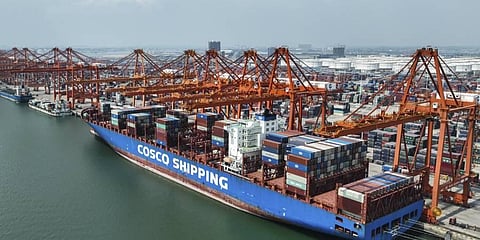

The increasing gap between India’s exports and imports poses a risk to the economy due to adverse global developments, analysts said, commenting on recent trade data.
When a country earns too little foreign exchange from its exports, it cannot import critical items from abroad – such as oil and food – leading to what is called a ‘balance of payments’ crisis. This leads to economic chaos and runaway inflation, as was seen in countries like Sri Lanka and Pakistan.
Despite exporting far less than what we import, India has traditionally avoided such a crisis due to two significant factors – the foreign exchange earned by IT companies and the foreign exchange remitted by overseas workers, particularly those in the Middle East.
For example, in FY23, India exported only USD 770.18 billion of goods, while it imported USD 892.18 billion, leading to a shortfall – or deficit – of USD 122 billion.
This was made good by services exports – mostly IT – of USD 178 billion and remittances of USD 100 billion.
However, the continued rise in oil prices – India’s biggest item of import – can disrupt this fine balance, analysts warned.
"We continue to expect external sector risks owing to protracted geopolitical conflicts causing uncertainty in energy prices and global rates likely to stay high for longer," said analysts from Kotak Institutional Equities, commenting on India’s import-export figures.
The oil market has been grappling with geopolitical tensions since the beginning of the Ukraine-Russia war in February 2022 till the ongoing Israel-Hamas war in October this year.
The unexpected outages have not only led to a significant reduction in the oil availability but also spiked the prices.
Further, unforeseen events in major oil-producing regions have created a situation where supply struggles to meet the growing global demand.
With this, India's oil imports grew to USD 9.7 billion and its trade deficit widened to USD 31.5 billion in October.
However, it’s not just crude oil imports that the country should be worried about as the country's edible oil has also risen by about 1.5 times and doubled in rupee value terms in the last decade.
Imports of vegetable oils used in cooking and frying foods touched a record 16.5 million tonnes (mt) in October, according to data from the Solvent Extractors’ Association of India (SEA).
In the past 10 years, India’s edible oil imports have increased from 11.6 mt (valued at Rs 60,750 crore) in 2013-14 to 16.5 mt (Rs 138,424 crore) in 2022-23.
Merchandise, or goods, imports hit an all-time high of USD 65 billion in October an increase of 12.3% year-on-year. The previous high import bill of USD 64.3 billion was recorded in June 2022.
The surge in imports was primarily led by a sharp rise in non-oil imports to USD 47.4 billion. In September, India's imports were at USD 53.8 billion.
The USD 11 billion increase compared to September was partly due to an increase in gold imports due to the festival season.
India's October gold imports surged 60% to a 31-month high as prices dropped ahead of the festive season.
The country’s other imports included silver at USD 1.2 billion, coke coal, and briquettes at USD 1 billion and fertilizers at USD 0.7 billion.
“Growth in imports was much higher than expected, which would normalize next month due to Diwali holidays. Going forward, we expect exports to remain muted, owing to a global slowdown,” said another analyst from Motilal Oswal.
Meanwhile, the country's exports in October grew marginally by 6.2% year-on-year to USD 33.6 billion.
However, oil exports fell to USD 6 billion and non-oil exports fell to USD 27.6 billion. The non-oil exports included primarily engineering goods, gems and jewellery, and drugs and pharmaceuticals.
The report further highlighted that a slowdown is expected in global growth in the second half of FY2024 while domestic growth is expected to remain relatively robust.
With this, India’s purchasing power remains intact however with the global demand remaining poor India’s imports are likely to overpower the country’s exports.
".. non-oil imports are likely to remain firm relative to non-oil exports," said the broking firm.
"We continue to expect headwinds to increase in 2HFY24E and maintain our FY2024 CAD/GDP estimate at 1.5%," it added.